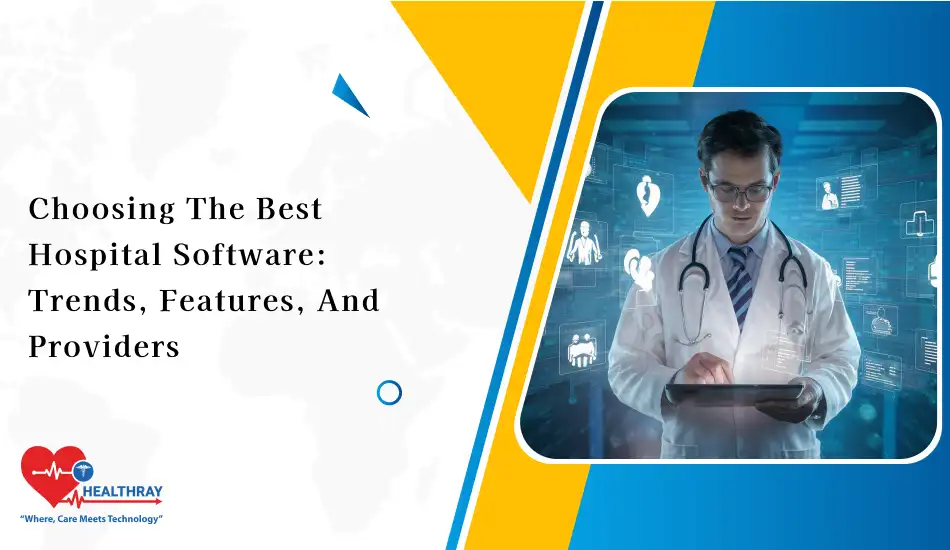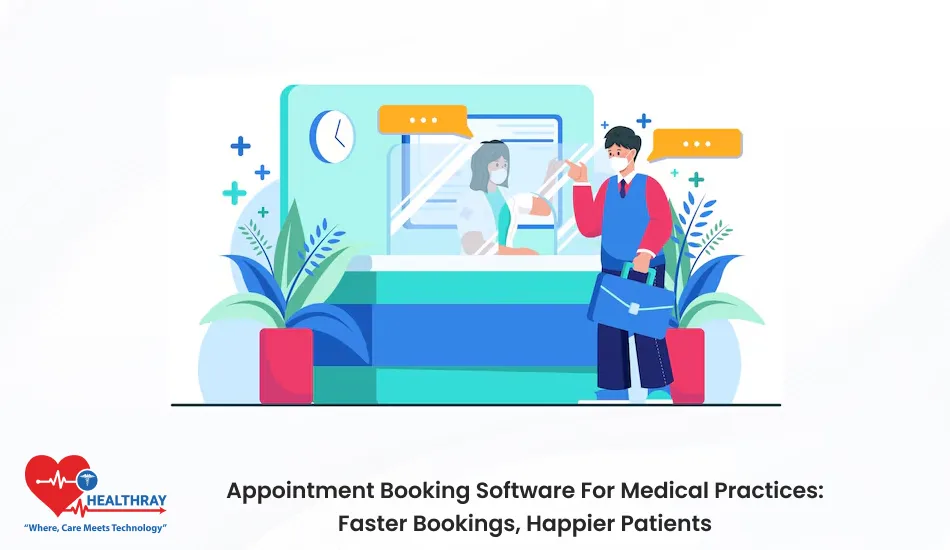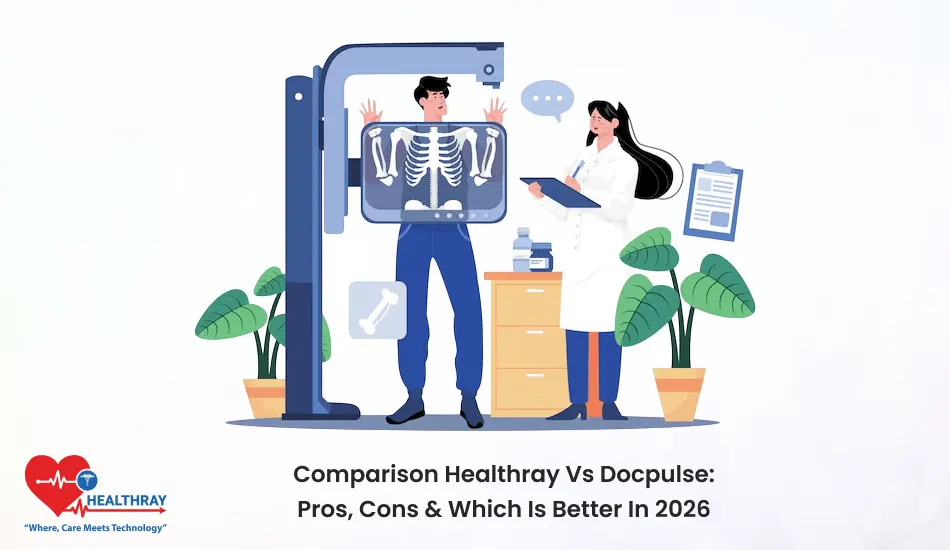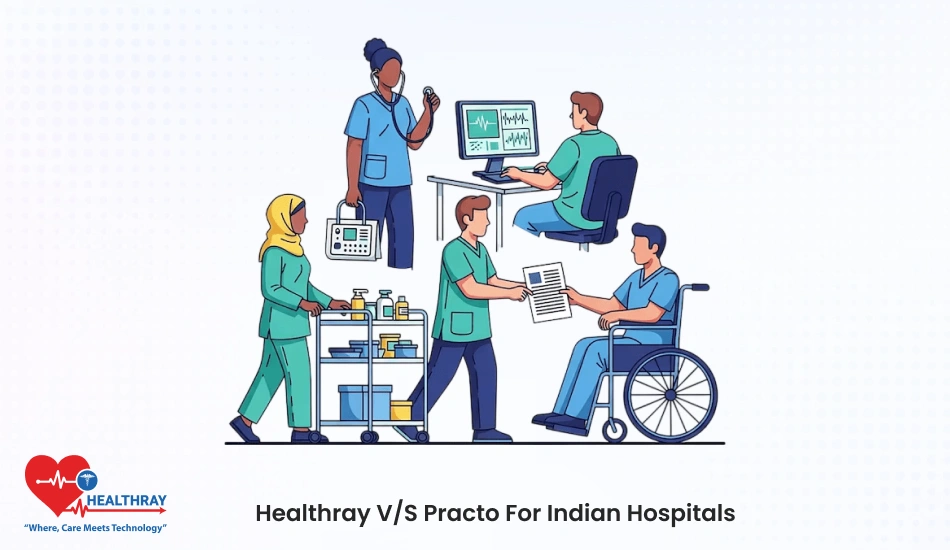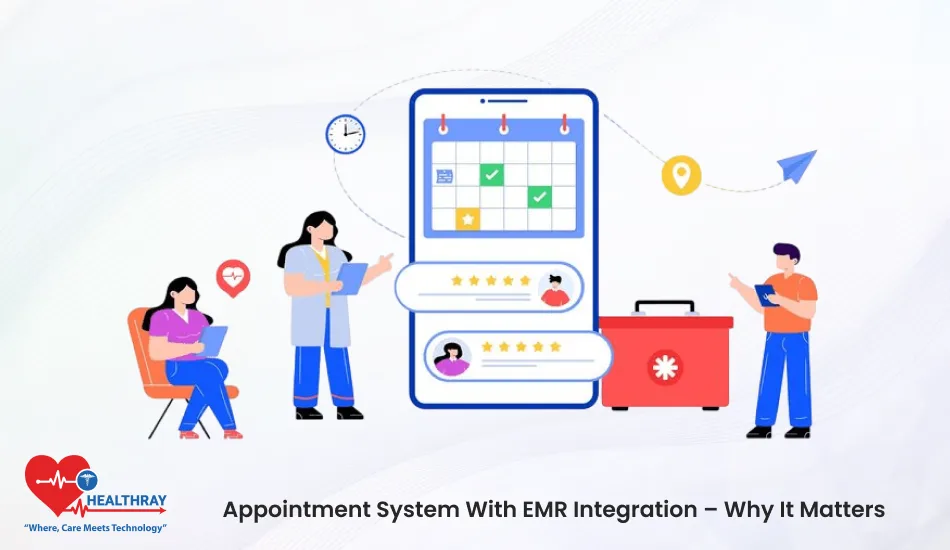Summary
Managing hospitals is really difficult for me. Sometimes records get scattered and sometimes staff coordination gets hampered. And paperwork is really endless. Then I started researching hospital software systems and finally I realized it’s a game-changer platform for every healthcare organization. Hospital software not only simplifies the operations but also boosts patient care and hospital efficiency.
Now the question is: How to choose the best software for hospitals among various options, providers and new trends. To clear all your confusion, here in this blog, I will discuss the best software for hospitals and how these platforms empower you to monitor multiple KPIS such as bed occupancy, billing cycles and discharge rates across multiple branches.
Introduction
Hospital management software has completely changed the workflows of healthcare institutions. These digital platforms have become an imperative tool for medical facilities to offer exceptional patient care and keep up operational productivity. These cutting-edge systems offer a unified infrastructure to manage all daily operations, including patient registration, electronic health records (EHR), billing, inventory management, compliance monitoring, and analytics under a single platform by integrating clinical, administrative, and financial workflows.
I am working in a healthcare agency of the USA. My team members were frequently bogged down in patient calls and clinic paperwork last year. Then we adopted a hospital software system in our workflows and suddenly everything got changed; billing got smooth and now I can easily fetch patient records in just one click. Plus, staff productivity improved. The biggest strength of modern software is scalability and interoperability. In today’s tech-savvy world, artificial intelligence, open API and embedded security have made the clinical management software a strategic enabler. Now, departments, external labs, pharmacies, insurance companies and government agencies can seamlessly collaborate and exchange data with each other. That’s the reason hospital management software has become a priority and helps hospitals to adapt seamlessly to changing regulations.
Key Features to Look For
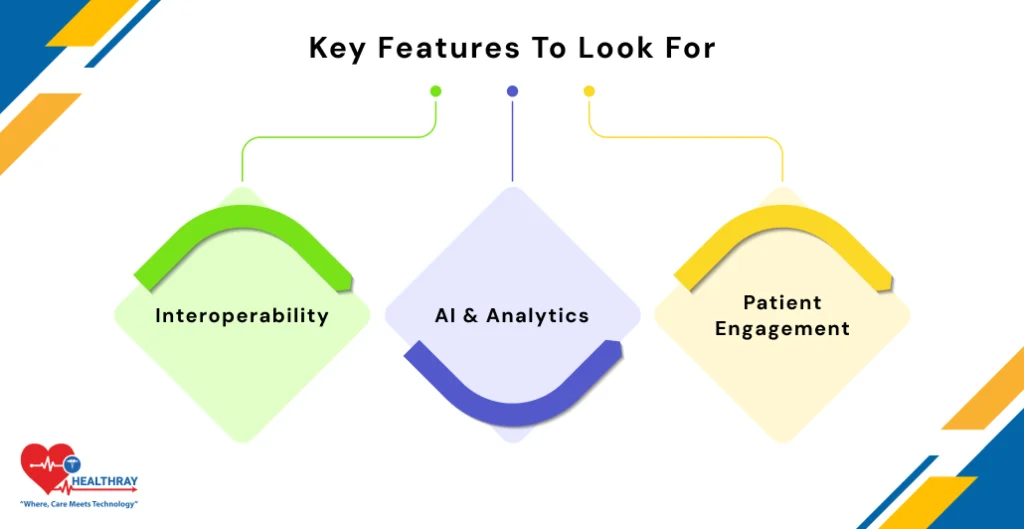
Let’s check out:
1. Interoperability
In a conventional system, all departments manage their own data; there is no connectivity with each other. Furthermore, all departments, such as labs, billings, pharmacy and EHR operate differently. As a result, there is a greater likelihood of mistakes, duplicate entries, and unnecessary delays for patients. But the good news is that with hospitals’ CRM interoperability, you can eliminate these silos.
Furthermore, now you can integrate all the departments, such as ehr,billings and labs and third-party applications, at a single place. Now, data can easily flow from one place to another smoothly without any manual exertion.
Overall, with hospital management software in India, staff overload gets reduced, and errors are minimized. Also, patients get a fast, accuarte and smooth care experience. And hospitals become more reliable and efficient.
2. AI & Analytics
Hospital staff mostly deal with scheduling, billing, patient records update and follow-ups manually. Furthermore, these repetitive tasks are time-consuming and increase the risks of error and staff are incapable of putting focus on patients’ care. With automation and AI in crm, hospital staff can smartly handle all the repetitive tasks without any manual exertion. Hospital management solutions automate the schedule and accurately generate billing and claims, instantly update patients’ records, and make clinical decision support faster and more informed.
Altogether, hospital management digital solutions drastically reduce staff workload, minimises error and now doctors spend more time on actual patient care. Plus, patients get fast and smooth experiences, which directly impacts patient satisfaction and loyalty.
3. Patient Engagement
In the traditional system, patients had to call multiple times in hospitals to inquire about their healthcare reports. Furthermore, hospitals faced delays in appointments and also billing transparency is not explicit. That makes patients feel frustrated and they shift to another hospital. Even I faced the same challenges, but the good update is that, with hospital crm engagement tools, your patients can easily manage all their healthcare reports and data.
Further, online portals provide them self-scheduling options, real-time updates, transparent billing and payment options and also automated post-consultation follow-ups. End result: patients feel more valued and connected. When hospitals are actively engaged in their healthcare journey, patients’ loyalty and trust both increase. In the long term, hospitals get higher retention and better recommendations and referrals.
Future Trends in Hospital Software
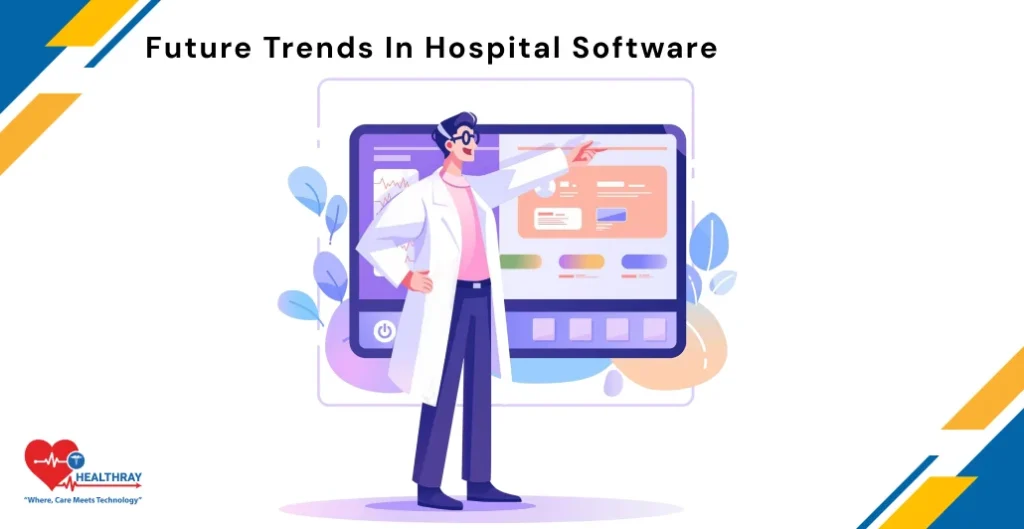
In the conventional hospital system, patient intakes, billings, and analytics require heavy manual efforts. Also, clinical decision support systems were slow and limited, thereby increasing the dependency of doctors on manual records and guesswork. But with AI-driven hospital software, you can easily fill these gaps. Furthermore, it automates, patient intake, billing and analytics, and clinical decision support provide real-time analytics. Cloud platforms will enhance interoperability and new compliance frameworks are making the patient data more secure and encrypted.
Future Outcomes:
- Patients will get mobile-first interfaces.
- Patients will get fast and convenient care through telemedicine support.
- Personal, data-driven engagement will make their trust and confidence stronger.
- Hospitals will get better efficacy, stronger compliance and long-term patient loyalty.
Top Hospital Software Solutions in 2025
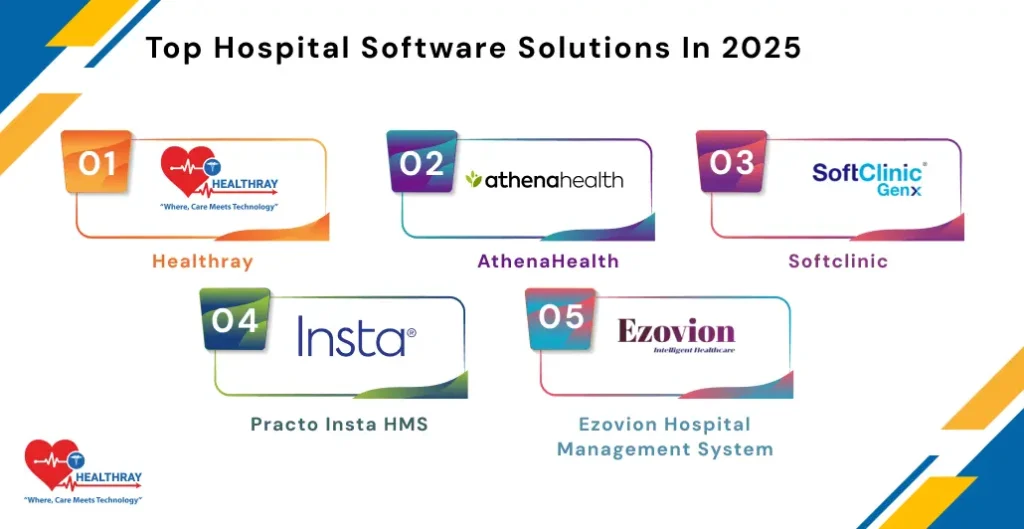
Let’s check out:
1. Healthray
Hospitals face huge challenges with managing patient registration, billing, labs and pharmacy operations in different platforms. Result? Workflows become complicated, billing error increases and doctors spend most of their time on paperwork instead of rendering patient care.
With healthray, a prominent AI-powered hospital software solutions helps you to solve all these challenges easily. Furthermore, it provides an intuitive solution through patient registration, billing, EHR integration, lab & pharmacy management, appointment automation, inventory tracking, insurance management aur telemedicine; all of which you can manage on a single platform.
It boasts real-time collaboration and customized templates that streamline the workflows; HIPAA compliant security protects the patient data and advanced analytics helps doctors make smarter decisions.
Features
- AI-powered automation for patient population management
- Seamless integration of EHR and engagement tools
- Dashboard-driven performance analytics
Step towards digital era with our healthcare solution
Revamp your hospital facilities and embrace change for better healthcare management. Ease in managing and organizing large medical datasets leads to effective analysis. Seize the opportunity now!
2. AthenaHealth
With Athenahealth’s comprehensive cloud-based platforms, hospitals can easily centralize patient information. Furthermore, patient integration tools and electronic health get integrated in a single place, consequently making the care delivery simpler and more efficient.
Overall, with athena healthcare, doctors get accurate and updated data instantly, and patients will get 24/7 engagement and also hospitals can improve their overall healthcare quality. Also, hospitals will get better collaboration, higher patient fulfillment and stronger trust in medical services.
Features
- Unified EHR and practice management
- Interoperability with external systems
- Patient engagement and communication tools
3. Softclinic
Softclinic Hms is an intuitive platform that covers all the modules: OPD/IPD, billing, pharmacy, laboratory, radiology, HR and insurance. Plus, its scalable architecture optimally fits in small clinics and multi-specialty hospitals. Softclinic creates integrated workflows for staff and hospitals, minimises delays and hospitals can seamlessly strengthen their efficiency. Overall, with softclinic digital solutions, patients get a fast, reliable and organized care experience, which in turn enhances both patient trust and satisfaction.
Features
- Scalable cloud-based solution
- Integrates medical records, billing, pharmacy, and HR.
4. Practo Insta HMS
Practo Insta HMS is a cloud and web platform that covers modular packages that cover basic to advanced hospital operations.
Furthermore, affordability and smooth integration are the biggest strengths of practo Insta HMS. With practo insta hms, hospitals can optimize their budget, staff can easily access their data from anywhere and operations run smoothly.
Overall, practo insta hms provide better efficacy and cost savings and an improved patient experience without compromising on features.
Features
- Modular, subscription-based plans
- Telemedicine and patient engagement integration
5. Ezovion Hospital Management System
The Ezovion hospital management system is a seamless cloud ecosystem that provides AI/ML-powered end-to-end hospital operations, patient registration, billing, insurance and government compliance. Furthermore, a hospital can centrally manage it with a simple and user-friendly UI.
Overall, ezovion hospital management system reduces the workload of staff and doctors and minimizes errors and hospitals can enhance their operational efficiency and compliance. Plus, patients get a smooth and organized care experience that enhances both satisfaction and trust.
Features
- Intuitive interface for staff
- Compliance and data security focus
- Integrated patient and administrative modules.
Conclusion
For US hospitals, choosing the right software in 2025 means balancing innovation, compliance, patient care, and affordability. Decision-makers should emphasize robust integration, regulatory readiness, and future-proofing to achieve the best outcomes in this dynamic landscape.
I hope the above articles provide you beneficial insights on the best software for hospitals and how these platforms help you enhance interoperability and how new compliance frameworks are making the patient data more secure and encrypted.
